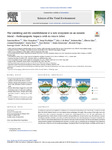Mostrar o rexistro simple do ítem
The Vanishing and the Establishment of a New Ecosystem on an Oceanic Island: Anthropogenic Impacts With No Return Ticket
| dc.contributor.author | Ritter, Catarina | |
| dc.contributor.author | Gonçalves, Vítor | |
| dc.contributor.author | Pla-Rabes, Sergi | |
| dc.contributor.author | de Boer, Erik | |
| dc.contributor.author | Bao, Roberto | |
| dc.contributor.author | Sáez, Alberto | |
| dc.contributor.author | Hernández, Armand | |
| dc.contributor.author | Sixto, Marta | |
| dc.contributor.author | Richter, Nora | |
| dc.contributor.author | Benavente Marín, Mario | |
| dc.contributor.author | Prego, Ricardo | |
| dc.contributor.author | Giralt, Santiago | |
| dc.contributor.author | Raposeiro, Pedro | |
| dc.date.accessioned | 2022-06-29T12:03:45Z | |
| dc.date.available | 2022-06-29T12:03:45Z | |
| dc.date.issued | 2022-03-31 | |
| dc.identifier.citation | Ritter, C., Gonçalves, V., Pla-Rabes, S., de Boer, E. J., Bao, R., Sáez, A., Hernández, A., Sixto, M., Richter, N., Benavente, M., Prego, R., Giralt, S., & Raposeiro, P. M. (2022). The vanishing and the establishment of a new ecosystem on an oceanic island – Anthropogenic impacts with no return ticket. Science of The Total Environment, 830, 154828. https://doi.org/10.1016/j.scitotenv.2022.154828 | es_ES |
| dc.identifier.issn | 0048-9697 | |
| dc.identifier.uri | http://hdl.handle.net/2183/31029 | |
| dc.description.abstract | [Abstract] A multiproxy approach was applied to a sediment core retrieved from the deep crater Lake Funda, located in the middle of the North Atlantic Ocean on Flores Island, Azores archipelago (Portugal). The purpose of this study was to determine how this ecosystem responded to natural and anthropogenic forces over the last millennium. We distinguished three main phases in lake evolution using multiproxy reconstructions and documentary sources. (A) Climate and lake catchment processes, as well as internal ones, were the main drivers of ecosystem variability before 1335 CE, when human disturbances were absent in the Lake Funda catchment. (B) The second phase is marked by unprecedented changes in all studied proxies between 1335 and 1560 CE, including abrupt changes in the composition and diversity of diatom and chironomid assemblages. Synergistic effects from high climate variability and the onset of human disturbances in the catchment (e.g., introduction of livestock) during the Medieval Climate Anomaly-Little Ice Age transition, led to an increase in lake trophic state from mesotrophic to eutrophic conditions. (C) In the last phase (1560 CE to the present), the eutrophic conditions in Lake Funda were maintained through a positive feedback loop between lake productivity and in-lake phosphorous recycling. Variability within the lake ecosystem was mainly associated with climate variability and internal lake dynamics (e.g., phosphorus remobilization). Our results show that a paleoecological approach is crucial to understanding lake ecological states in the present-day in order to develop locally adapted management and restoration strategies. A long-term perspective enables us to understand the harmful consequences of ongoing climate change and human disturbances on lake ecosystems. | es_ES |
| dc.description.sponsorship | The research was funded by the Portuguese Science Foundation (FCT) (DL57/2016/ICETA/EEC2018/25) and the DISCOVERAZORES (PTDC/CTA-AMB/28511/2017), together with the PaleoModes project (CGL2016-75281-C2) funded by the Spanish Ministry of Economy and Competitiveness, and the Luso-American Foundation. AH is funded by the Spanish Ministry of Science and Innovation through the Ramón y Cajal Scheme (RYC2020-029253-I) | es_ES |
| dc.description.sponsorship | Portugal. Fundação para a Ciência e a Tecnologia; DL57/2016/ICETA/EEC2018/25 | es_ES |
| dc.description.sponsorship | Portugal. Fundação para a Ciência e a Tecnologia; PTDC/CTA-AMB/28511/2017 | es_ES |
| dc.language.iso | eng | es_ES |
| dc.publisher | Elsevier | es_ES |
| dc.relation | info:eu-repo/grantAgreement/AEI/Plan Estatal de Investigación Científica y Técnica y de Innovación 2013-2016/CGL2016-75281-C2-2-R/ES/EL CLIMA HOLOCENO E IMPACTOS ECOLOGICOS DE LA INTERRELACION ENTRE EL PATRON DEL ATLANTICO ESTE (EA) Y LA OSCILACION DEL ATLANTICO NORTE (NAO) EN EL SUROESTE ATLANTICO EUROPEO/ | |
| dc.relation | info:eu-repo/grantAgreement/AEI/Plan Estatal de Investigación Científica y Técnica y de Innovación 2017-2020/RYC2020-029253-I/ES/ | |
| dc.relation.uri | https://doi.org/10.1016/j.scitotenv.2022.154828 | es_ES |
| dc.rights | Atribución-NoComercial-SinDerivadas 4.0 Internacional | es_ES |
| dc.rights.uri | http://creativecommons.org/licenses/by-nc-nd/4.0/ | * |
| dc.subject | Anthropogenic impacts | es_ES |
| dc.subject | Eutrophication | es_ES |
| dc.subject | Remote oceanic islands | es_ES |
| dc.subject | Conservation management | es_ES |
| dc.subject | Multiproxy reconstruction | es_ES |
| dc.subject | Trophic changes | es_ES |
| dc.title | The Vanishing and the Establishment of a New Ecosystem on an Oceanic Island: Anthropogenic Impacts With No Return Ticket | es_ES |
| dc.type | info:eu-repo/semantics/article | es_ES |
| dc.rights.access | info:eu-repo/semantics/openAccess | es_ES |
| UDC.journalTitle | Science of The Total Environment | es_ES |
| UDC.volume | 830 | es_ES |
| UDC.startPage | 154828 | es_ES |
Ficheiros no ítem
Este ítem aparece na(s) seguinte(s) colección(s)
-
GI-GRICA - Artigos [49]






